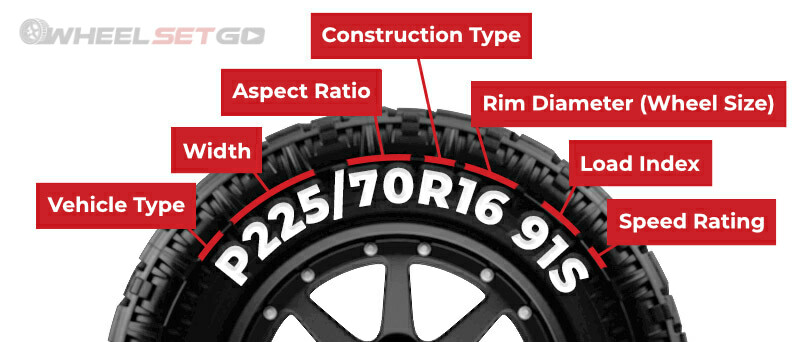Finding the Right Tire Size for Your Vehicle
Posted by WheelSetGo on 20th Jun 2024

Finding the Right Tire Size for Your Vehicle: A Comprehensive Guide
Choosing the right tire size for your vehicle is crucial for ensuring safety, performance, and longevity. Incorrect tire sizing can lead to poor handling, increased wear, and even safety hazards. Whether you're replacing worn-out tires or upgrading for better handling, understanding how to select the appropriate tire size is essential. In this guide, we’ll break down the key factors to consider and provide practical tips to help you make an informed decision.
Understanding Tire Size Basics
The first step in choosing the right tire size is decoding the numbers and letters on the sidewall of your current tires. This alphanumeric code provides essential information about the tire’s dimensions and capabilities. For example, a tire size of P225/70R16 91S can be broken down as follows:
- P: Tire type (P for passenger vehicles)
- 225: Tire width in millimeters
- 70: Aspect ratio (height of the sidewall as a percentage of the width)
- R: Radial construction
- 16: Diameter of the wheel in inches
- 91S: Load index and speed rating

Key Factors to Consider When Choosing Tire Size
1. Vehicle Manufacturer’s Recommendations
Always start with your vehicle manufacturer’s recommendations. These can be found in the owner’s manual or on the tire information placard located on the driver’s side door jamb. Using the recommended tire size ensures optimal performance and safety.
2. Driving Conditions
Consider the typical driving conditions you encounter:
- Highways: Prioritize comfort and fuel efficiency.
- Off-road: Larger, more robust tires with a higher aspect ratio are preferable.
- Snow/Ice: Winter tires with a suitable size are essential.
3. Performance Goals
Your performance goals also play a significant role. For better handling and cornering, low-profile tires (lower aspect ratio) might be suitable. For a smoother ride, higher-profile tires can absorb road imperfections more effectively.
4. Load Carrying Capacity
Ensure the tires you choose can handle the load capacity of your vehicle. The load index, indicated by a number on the sidewall, corresponds to the maximum weight a tire can support. Overloading tires can lead to premature wear and potential safety hazards.
5. Speed Rating
The speed rating, denoted by a letter, indicates the maximum speed a tire can safely sustain. It’s essential to match or exceed the speed rating recommended by the vehicle manufacturer, especially if you drive at higher speeds regularly.
Measuring Your Current Tires
If you’re uncertain about your current tire size, you can use our tire size calculator to quickly and accurately determine the right size for your vehicle. This calculator helps maintain the same overall diameter if you're considering switching to wider tires, ensuring that your vehicle's performance and safety are not compromised.
Common Tire Sizing Mistakes to Avoid
- Ignoring Manufacturer’s Guidelines: Deviating from the recommended tire size can negatively impact vehicle handling and safety.
- Overlooking Load Index and Speed Rating: These specifications are crucial for maintaining tire integrity and performance.
- Mismatched Tires: Ensure all four tires match in size, load index, and speed rating for balanced performance, except in cases of staggered factory fitments.
Wrapping Up
Choosing the right tire size is a vital aspect of vehicle maintenance that affects safety, performance, and comfort. By understanding tire size basics, considering your driving conditions and performance goals, and adhering to manufacturer recommendations, you can make an informed decision. If in doubt, consult with a tire professional to ensure you select the best tires for your vehicle.
For personalized assistance, contact WheelSetGo at 320-247-6160. Our experts are ready to help you find the perfect tires to match your needs.
